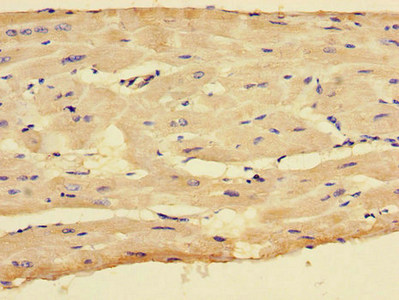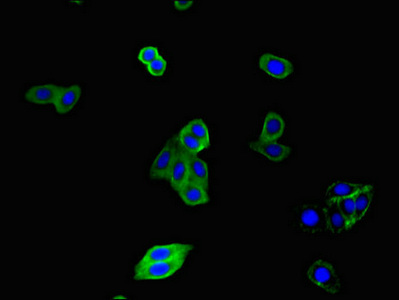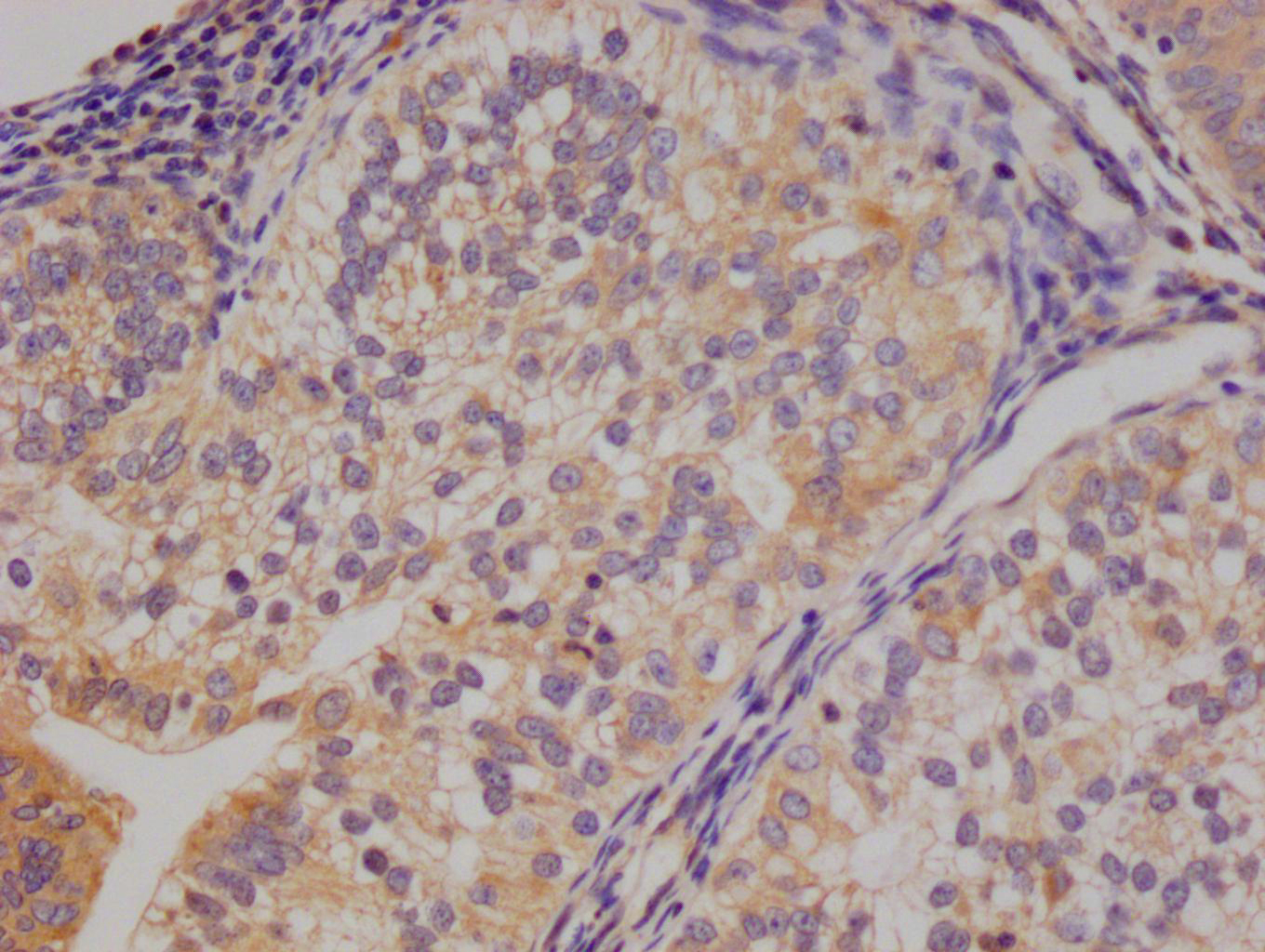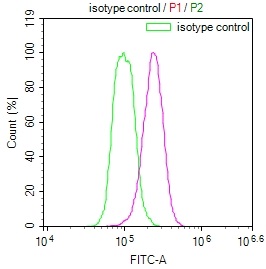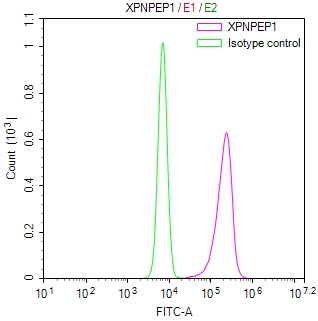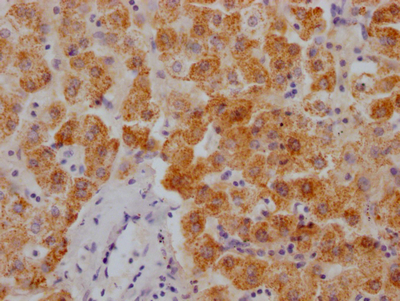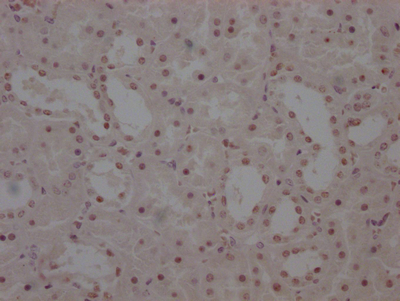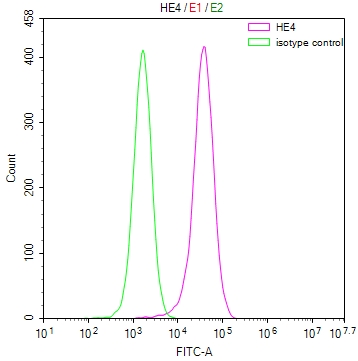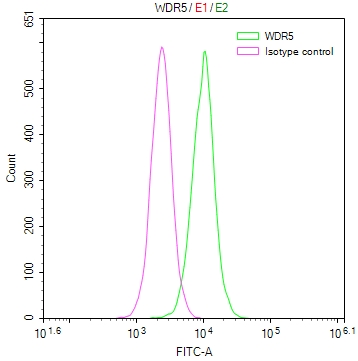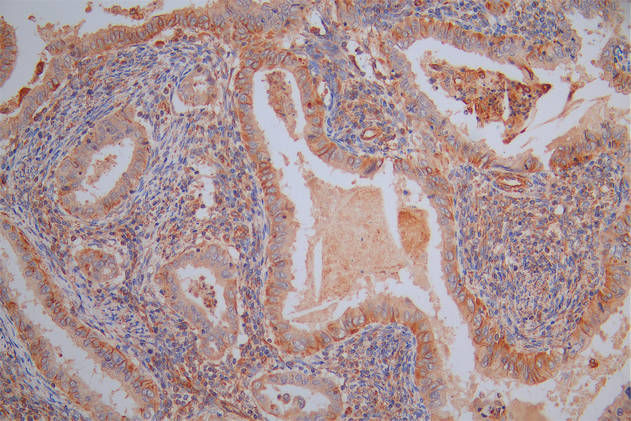CX3CR1 Antibody
-
中文名稱(chēng):CX3CR1兔多克隆抗體
-
貨號(hào):CSB-PA006236LA01HU
-
規(guī)格:¥440
-
圖片:
-
其他:
產(chǎn)品詳情
-
產(chǎn)品名稱(chēng):Rabbit anti-Homo sapiens (Human) CX3CR1 Polyclonal antibody
-
Uniprot No.:
-
基因名:
-
別名:CX3CR1; CMKBRL1; GPR13; CX3C chemokine receptor 1; C-X3-C CKR-1; CX3CR1; Beta chemokine receptor-like 1; CMK-BRL-1; CMK-BRL1; Fractalkine receptor; G-protein coupled receptor 13; V28
-
宿主:Rabbit
-
反應(yīng)種屬:Human
-
免疫原:Recombinant Human CX3C chemokine receptor 1 protein (298-351AA)
-
免疫原種屬:Homo sapiens (Human)
-
標(biāo)記方式:Non-conjugated
本頁(yè)面中的產(chǎn)品,CX3CR1 Antibody (CSB-PA006236LA01HU),的標(biāo)記方式是Non-conjugated。對(duì)于CX3CR1 Antibody,我們還提供其他標(biāo)記。見(jiàn)下表:
-
克隆類(lèi)型:Polyclonal
-
抗體亞型:IgG
-
純化方式:>95%, Protein G purified
-
濃度:It differs from different batches. Please contact us to confirm it.
-
保存緩沖液:Preservative: 0.03% Proclin 300
Constituents: 50% Glycerol, 0.01M PBS, PH 7.4 -
產(chǎn)品提供形式:Liquid
-
應(yīng)用范圍:ELISA, IHC, IF
-
推薦稀釋比:
Application Recommended Dilution IHC 1:20-1:200 IF 1:50-1:200 -
Protocols:
-
儲(chǔ)存條件:Upon receipt, store at -20°C or -80°C. Avoid repeated freeze.
-
貨期:Basically, we can dispatch the products out in 1-3 working days after receiving your orders. Delivery time maybe differs from different purchasing way or location, please kindly consult your local distributors for specific delivery time.
-
用途:For Research Use Only. Not for use in diagnostic or therapeutic procedures.
相關(guān)產(chǎn)品
靶點(diǎn)詳情
-
功能:Receptor for the C-X3-C chemokine fractalkine (CX3CL1) present on many early leukocyte cells; CX3CR1-CX3CL1 signaling exerts distinct functions in different tissue compartments, such as immune response, inflammation, cell adhesion and chemotaxis. CX3CR1-CX3CL1 signaling mediates cell migratory functions. Responsible for the recruitment of natural killer (NK) cells to inflamed tissues. Acts as a regulator of inflammation process leading to atherogenesis by mediating macrophage and monocyte recruitment to inflamed atherosclerotic plaques, promoting cell survival. Involved in airway inflammation by promoting interleukin 2-producing T helper (Th2) cell survival in inflamed lung. Involved in the migration of circulating monocytes to non-inflamed tissues, where they differentiate into macrophages and dendritic cells. Acts as a negative regulator of angiogenesis, probably by promoting macrophage chemotaxis. Plays a key role in brain microglia by regulating inflammatory response in the central nervous system (CNS) and regulating synapse maturation. Required to restrain the microglial inflammatory response in the CNS and the resulting parenchymal damage in response to pathological stimuli. Involved in brain development by participating in synaptic pruning, a natural process during which brain microglia eliminates extra synapses during postnatal development. Synaptic pruning by microglia is required to promote the maturation of circuit connectivity during brain development. Acts as an important regulator of the gut microbiota by controlling immunity to intestinal bacteria and fungi. Expressed in lamina propria dendritic cells in the small intestine, which form transepithelial dendrites capable of taking up bacteria in order to provide defense against pathogenic bacteria. Required to initiate innate and adaptive immune responses against dissemination of commensal fungi (mycobiota) component of the gut: expressed in mononuclear phagocytes (MNPs) and acts by promoting induction of antifungal IgG antibodies response to confer protection against disseminated C.albicans or C.auris infection. Also acts as a receptor for C-C motif chemokine CCL26, inducing cell chemotaxis.; (Microbial infection) Acts as coreceptor with CD4 for HIV-1 virus envelope protein.; (Microbial infection) Acts as coreceptor with CD4 for HIV-1 virus envelope protein. May have more potent HIV-1 coreceptothr activity than isoform 1.; (Microbial infection) Acts as coreceptor with CD4 for HIV-1 virus envelope protein. May have more potent HIV-1 coreceptor activity than isoform 1.
-
基因功能參考文獻(xiàn):
- Study demonstrated that CX3CL1/CX3CR1 was overexpressed in prostate cancer tissues with spinal metastasis compared with primary tumors. Overexpression of CX3CR1 increased cell proliferation, migration and invasion. Also, study observed that EGFR/Src/FAK pathway was activated by CX3CL1/CX3CR1. PMID: 30066854
- CX3CR1 major allele carriers V249 and T280 are significantly associated with an increased total arterial blood volume of the whole brain, especially around the bilateral precuneus, left posterior cingulate cortex, and left posterior parietal cortex. PMID: 29485193
- investigated the association of CX3CR1 839C/T, CX3CR1 745G/A, polymorphisms with Age-Related Macular Degeneration (AMD) risk. These associated with an increased AMD risk (CX3CR1 839C/T, additive model: aOR=2.682, 95% CI=1.119-5.709, P=0.022, recessive model: aOR=2.729, 95% CI=1.141-6.048, P=0.010; CX3CR1 745G/A, additive model: aOR=2.614, 95% CI=1.231-6.012, P=0.020, recessive model: aOR=2.340, 95% CI=1.227-5.993, P=0.011 PMID: 29565837
- CX3CR1 regulated chondrocyte proliferation. PMID: 29217163
- We detected a statistically significant association between the variant Ala55Thr in CX3CR1 with schizophrenia and autism spectrum disorder phenotypes PMID: 28763059
- This study shown that CX3CR1 expression in both Microglia and Astrocytes in hippocampus in affected by stroke, Alzheimer's disease, and Lewy body dementia. PMID: 28398520
- The US28 gene product has maintained the function of the ancestral gene and has the ability to bind and signal in response to human CX3CL1, the natural ligand for CX3CR1. PMID: 28315475
- Our findings demonstrate that motility, invasion, and contact-independent growth of PDAC cells all increase following CX3CL1 exposure, and that antagonism of CX3CR1 by the inhibitor JMS-17-2 reduces each of these phenotypes and correlates with a downregulation of AKT phosphorylation. PMID: 29274778
- in Crohn's disease patients, a missense mutation in the gene encoding CX3CR1 was identified and found to be associated with impaired antifungal responses PMID: 29326275
- Soluble FKN that was efficiently shed from the surface of LPS-activated ECs in response to binding of CD16(+) monocytes to ECs, diminished monocyte adhesion in down-regulating CX3CR1 expression on the surface of CD16(+) monocytes resulting in decreased TNF-secretion. PMID: 27031442
- CX3CR1 genetic variants were not associated with risk of atherosclerotic coronary heart disease and glucometabolic traits in European ancestry cohort. In a South Asian cohort, identified CX3CR1 SNP associated with myocardial infarction and type II diabetes mellitus. PMID: 27013693
- FKN and CX3CR1 expression was significantly increased in pancreatic ductal adenocarcinoma (PDAC) tissues, especially in the metastatic samples, and was highly-correlated with severity of PDAC. Ectopic expression of FKN promoted the proliferation and migration of PDAC, while knockdown of CX3CR1 reversed the function of FKN. PMID: 28986258
- CX3CL1 is upregulated in both human and murine tumors following VEGF signaling blockade, resulting in recruitment of CX3CR1+Ly6Clo monocytes into the tumor PMID: 28691930
- The fractalkine functions on the activation of the AKT/NF-kappaB/p65 signalling cascade and regulation of the antiapoptosis process in pancreatic cancer cells. PMID: 28845524
- High expression of CX3CR1 correlates with significantly shorter survival, specifically in post-menopausal patients with advanced and terminal stages of the disease. Taken together, this support a key regulatory role for the fractalkine axis in advanced and relapsed peritoneal metastasis in epithelial ovarian carcinoma. PMID: 27941884
- rs3732378 and rs3732379 susceptibility loci for developmental dysplasia of the hip PMID: 27176135
- V249I genotype of the fractalkine receptor showed a protector role in patients with type 2 diabetes. The T280M genotype is associated with increased carotid intima-media thickness in Mexican individuals with or without type 2 diabetes PMID: 28128806
- CX3CR1 genetic variation sows a possible association with hypertension, diabetes mellitus and atherosclerosis comorbidities in patients treated with hemodialysis. PMID: 27118566
- this study shows that the expression of CX3CR1 on tonsillar CD8-positive cells is higher in IgA nephropathy patients PMID: 28196748
- Low CCRL1 expression is associated with hepatocellular carcinoma. PMID: 26813566
- Recent works show that, in allergic diseases, there is an increased expression of fractalkine/CX3CL1 and its unique receptor CX3CR1 and that this chemokine does not act as chemoattractant. In allergic asthma, CX3CR1 expression regulates Th2 and Th1 cell survival in the inflammatory lung, while, in atopic dermatitis, it regulate Th2 and Th1 cell retention into the inflammatory site. [review] PMID: 27011244
- cxc3cr1 is a biomarker for Alzehein disease. PMID: 26567742
- CX3CR1 is expressed in the normal, cancer adjacent normal, inflammatory, and malignant fallopian epithelium. PMID: 26633537
- genetic polymorphism is associated with delayed allograft function in Polish kidney transplat recipients PMID: 25898802
- CX3CR1 T allele of rs3732379 might have a positive association with the susceptibility of age-related macular degeneration PMID: 26464724
- CX3CR1 is expressed differentially in human monocytes during differentiation. PMID: 25502213
- This meta-analysis suggested that CX3CR1 T280M and V249I polymorphisms may not be associated with an increased risk of AMD based on current published data. PMID: 26651305
- Data show that fractalkine receptor CX3CR1 expression is decreased in both murine and human glioblastoma (GBM) tissue. PMID: 25987130
- Respiratory syncytial virus G protein and host CX3CR1 interaction is important in infection and infection-induced responses of the airway epithelium. PMID: 26297201
- Association of hydrogen sulfide with alterations of monocyte chemokine receptors, CCR2 and CX3CR1 in patients with coronary artery disease PMID: 26123579
- Specific pro-inflammatory monocyte subpopulations positive for CD16 and the co-expressed chemokine receptor, CX3CR1, are discriminative for chronic kidney disease stage 5 on hemodialysis patients. PMID: 25830914
- CX3CR1 is expressed in differentiated human ciliated airway cells and co-localizes with respiratory syncytial virus on cilia in a G protein-dependent manner. PMID: 26107373
- CX3CL1 and CX3CR1 may contribute to the formation of coronary atherosclerotic plaque in coronary artery disease PMID: 25845619
- Fractalkine receptor polymorphisms may not contribute to the molecular pathogenesis of ulcerative colitis. PMID: 26042517
- the results from the present study support the concept of the CX3CL1-mediated activation of the progression of the multiple myeloma via CX3CR1. PMID: 25962684
- this is the first demonstration of the role of DNA methylation in regulating the expression of the CX3CR1 gene by CD8+ T cells and the potential biological relevance of increased expression of CX3CR1 by IL-7Ra(low) effector memory CD8+ T cells in humans. PMID: 26276874
- The study found a significantly lower expression of CX3CR1 on CD8+ T cells in the neovascular age-related macular degeneration group compared to the control group (p = 0.04). PMID: 25503251
- The high expression of CX3CR1 was associated with prolonged isolated thrombocytopenia after allogeneic hematopoietic stem cell transplantation. PMID: 26141368
- The progression rate of ALS symptoms and the survival time is affected in patients with one or two copies of the CX3CR1 249I allele. The CX3CR1 is the most potent ALS survival genetic factor reported to date PMID: 24806473
- An inverse pattern was observed in gene expression levels of fractalkine receptor (CX3CR1) might be a compensatory mechanism. PMID: 24930044
- Findings suggest that overexpression of CX3CR1 promotes gastric cancer metastasis, proliferation and survival and, might play a physiological role in normal gastric tissue renewal and/or tissue remodeling after injury. PMID: 25482732
- Fractalkine and CX3CR1 may play a role in the pathogenesis of pSS, including extraglandular manifestations. PMID: 25320221
- Cx3cr1-deficient mononuclear phagocytes express increased P2X7 receptors, which stimulates IL-1Beta secretion. PMID: 25948251
- A higher percentage of circulating CD4(+) T-cells expressed CX3CR1 in relapsing-remitting multiple sclerosis compared to healthy controls. PMID: 25596452
- Data show that chemokine domain of fractalkine (FKN-CD) can activate alphavbeta3 integrin in the absence of fractalkine receptor CX3CR1, but that this activation requires the direct binding of FKN-CD to alphavbeta3. PMID: 24789099
- These findings suggest that CCR2, CX3CR1, RANTES and SDF1 gene variants seem to play an important role in the dynamics of HIV infection and could be used as drug or vaccine targets. PMID: 25313609
- Insulin resistance increases plaque vulnerability by augmenting the CX3CL1/CX3CR1 axis, which is mechanistically linked to reduced vascular smooth muscle cell survival PMID: 24788416
- our results confirm previous findings on the predominance of R5 tropism among HIV-1 treatment-naive subjects and reveal an association between a higher frequency of R5 tropism and the CX3CR1 A allele and a lower additive genetic score. PMID: 24750723
- CX3CR1 (T280M and V249I) and PLEKHA1 (A320T) polymorphisms were not found to be associated with age-related macular degeneration in an Indian population. PMID: 25050486
- Suggest that CCRL1 impairs chemotactic events associated with CCR7 in the progression and metastasis of hepatocellular carcinoma. PMID: 25255875
顯示更多
收起更多
-
相關(guān)疾病:Macular degeneration, age-related, 12 (ARMD12)
-
亞細(xì)胞定位:Cell membrane; Multi-pass membrane protein.
-
蛋白家族:G-protein coupled receptor 1 family
-
組織特異性:Expressed in lymphoid and neural tissues. Expressed in lymphocyte subsets, such as natural killer (NK) cells, gamma-delta T-cells and terminally differentiated CD8(+) T-cells. Expressed in smooth muscle cells in atherosclerotic plaques.
-
數(shù)據(jù)庫(kù)鏈接:
Most popular with customers
-
-
YWHAB Recombinant Monoclonal Antibody
Applications: ELISA, WB, IHC, IF, FC
Species Reactivity: Human, Mouse, Rat
-
-
-
-
-
-

